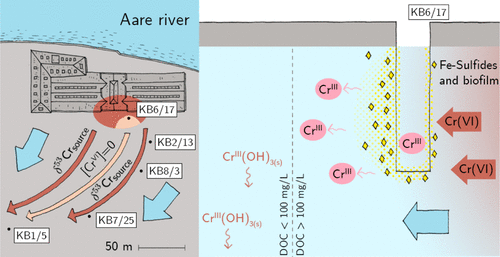当前位置:
X-MOL 学术
›
ACS Earth Space Chem.
›
论文详情
Our official English website, www.x-mol.net, welcomes your feedback! (Note: you will need to create a separate account there.)
In Situ Biostimulation of Cr(VI) Reduction in a Fast-Flowing Oxic Aquifer
ACS Earth and Space Chemistry ( IF 3.4 ) Pub Date : 2020-11-02 , DOI: 10.1021/acsearthspacechem.0c00200 Tatiana Nazarova 1, 2 , Daniel S. Alessi 3, 4 , David J. Janssen 1 , Rizlan Bernier-Latmani 4 , Christoph Wanner 1
ACS Earth and Space Chemistry ( IF 3.4 ) Pub Date : 2020-11-02 , DOI: 10.1021/acsearthspacechem.0c00200 Tatiana Nazarova 1, 2 , Daniel S. Alessi 3, 4 , David J. Janssen 1 , Rizlan Bernier-Latmani 4 , Christoph Wanner 1
Affiliation

|
Hexavalent chromium is among the most common and hazardous inorganic contaminants in soils and groundwater. A promising in situ bioremediation approach is the delivery of electron donors to stimulate microbially mediated Cr(VI) reduction, producing relatively insoluble Cr(III) precipitates. Even though this strategy has been implemented successfully in the past, it was primarily under favorable hydrological conditions, such as relatively slow groundwater flow velocities. To evaluate whether microbially mediated Cr(VI) reduction can be sustained at high groundwater flow velocities and under nearly oxygen-saturated conditions, we have conducted laboratory-scale column experiments and a field-scale pilot study using molasses as the electron donor. Despite the unfavorable conditions, both experiments provided clear evidence for microbially mediated Cr(VI) reduction. In particular, the well used for injection in the field experiment became anoxic after two months of injection and the Cr(VI) concentration decreased by a factor of six. After stopping the injection, these conditions prevailed for at least four months. In the column experiments, Cr(VI) reduction was accompanied by distinct Cr isotopic fractionation characterized by an enrichment factor of −1.25‰. In contrast, Cr isotope data collected from the field experiment were ambiguous, which was because of the complexation of Cr(III) with organic carbon and the heterogeneous distribution of molasses due to the presence of narrow preferential flow paths. A substantial injectivity decrease likely caused by the formation of biofilm and the precipitation of Fe sulfides formed an additional challenge during the field experiment. Our data, however, also suggest that most of the identified challenges could be addressed by limiting the targeted dissolved organic carbon concentrations to about 10 mg/L. In conclusion, the injection of molasses constitutes a promising bioremediation strategy for the long-term treatment of Cr(VI) contamination even at high flow rates and under oxic conditions.
中文翻译:

快速流动的含水层中Cr(VI)还原的原位生物刺激
六价铬是土壤和地下水中最常见和最危险的无机污染物之一。有前途的原地生物修复方法是输送电子供体以刺激微生物介导的Cr(VI)还原,从而产生相对不溶的Cr(III)沉淀物。尽管该策略过去已成功实施,但它主要是在有利的水文条件下进行的,例如地下水流速相对较慢。为了评估微生物介导的Cr(VI)还原是否可以在高地下水流速和接近氧气饱和的条件下持续维持,我们进行了实验室规模的柱实验和使用糖蜜作为电子供体的现场规模的中试研究。尽管条件不利,但两个实验都为微生物介导的六价铬还原提供了明确的证据。尤其是,注入两个月后,用于现场实验的注入井变得缺氧,Cr(VI)浓度降低了六倍。停止注射后,这些情况持续了至少四个月。在柱实验中,Cr(VI)的还原伴随着独特的Cr同位素分馏,其富集系数为-1.25‰。相反,从野外实验收集的Cr同位素数据是模棱两可的,这是由于Cr(III)与有机碳的络合以及糖蜜的异质分布(由于存在狭窄的优先流动路径)所致。在田间试验期间,可能由于生物膜的形成和硫化铁的沉淀而引起的大量注入降低是另一个挑战。但是我们的数据 还建议通过将目标溶解的有机碳浓度限制在约10 mg / L可以解决大多数已确定的挑战。总之,糖蜜的注入构成了一种有前途的生物修复策略,即使在高流量和高氧条件下,也可以长期处理Cr(VI)污染。
更新日期:2020-11-19
中文翻译:

快速流动的含水层中Cr(VI)还原的原位生物刺激
六价铬是土壤和地下水中最常见和最危险的无机污染物之一。有前途的原地生物修复方法是输送电子供体以刺激微生物介导的Cr(VI)还原,从而产生相对不溶的Cr(III)沉淀物。尽管该策略过去已成功实施,但它主要是在有利的水文条件下进行的,例如地下水流速相对较慢。为了评估微生物介导的Cr(VI)还原是否可以在高地下水流速和接近氧气饱和的条件下持续维持,我们进行了实验室规模的柱实验和使用糖蜜作为电子供体的现场规模的中试研究。尽管条件不利,但两个实验都为微生物介导的六价铬还原提供了明确的证据。尤其是,注入两个月后,用于现场实验的注入井变得缺氧,Cr(VI)浓度降低了六倍。停止注射后,这些情况持续了至少四个月。在柱实验中,Cr(VI)的还原伴随着独特的Cr同位素分馏,其富集系数为-1.25‰。相反,从野外实验收集的Cr同位素数据是模棱两可的,这是由于Cr(III)与有机碳的络合以及糖蜜的异质分布(由于存在狭窄的优先流动路径)所致。在田间试验期间,可能由于生物膜的形成和硫化铁的沉淀而引起的大量注入降低是另一个挑战。但是我们的数据 还建议通过将目标溶解的有机碳浓度限制在约10 mg / L可以解决大多数已确定的挑战。总之,糖蜜的注入构成了一种有前途的生物修复策略,即使在高流量和高氧条件下,也可以长期处理Cr(VI)污染。


























 京公网安备 11010802027423号
京公网安备 11010802027423号